
In the ever-evolving landscape of technology, modern businesses are turning towards innovative solutions to gain a competitive edge. One such solution lies in voice recognition technology and its ability to provide demographic analysis. Leveraging this technology for age and gender analysis can unlock powerful insights into customer preferences, enhancing the effectiveness of marketing strategies.
Voice recognition technology is a subset of Natural Language Processing (NLP) that uses algorithms to analyze spoken language. The primary function of this technology revolves around converting spoken words into written format, but it's their secondary functions that allure marketers – the ability to determine key demographic information like age and gender.

The system leverages machine learning models trained on vast datasets of spoken language. These models analyze various aspects of speech – intonation, pitch, speed, and even vocabulary usage – which all contribute towards identifying a speaker's age and gender. Regardless of the complexity of the task, these models can give reasonable estimates with a high degree of accuracy.
Once age and gender data is obtained, companies can utilize it to personalize their products and tailor their marketing strategies accordingly. With the rise of voice user interfaces (VUIs) such as Amazon's Alexa and Google Home, there is an escalating need for understanding the demographics of voice data to create a more effective and customized user experience.
Voice-based demographic analysis, while seemingly futuristic, is undoubtedly an accessible reality for today's marketers. Embracing this technology not only grants us a deeper understanding of our customer base, but also opens new avenues for customer interaction and engagement.
The emergence of voice-based age and gender analysis technologies signifies a new frontier for understanding consumers and enhancing targeted marketing strategies. This realm of technology capitalizes on advancements in machine learning, algorithms, and pattern recognition models, paving way for both accuracy and precision in deriving demographic data from simple voice inputs.
At the heart of voice analysis technology lies the Deep Convolutional Neural Network (DCNN). This type of artificial neural network spurs the initial processing stage of voice data, transforming the audio input into a spectrogram. This visual representation illustrates how spectral densities of the voice input change over time, proving instrumental in age and gender identification.
The Supervised Machine Learning approach champions the prediction phase, enabling the model to infer age and gender based on known outputs from past data. Using voice data from various age and gender groups, the model discerns patterns and variations that define each demographic. Once trained, the model can predict the age and gender of unknown voice inputs with remarkable accuracy.
Complimenting these workings are complex algorithms such as Gaussian Mixture Models (GMM) and Support Vector Machines (SVM). GMMs are used for identifying patterns and clusters within the voice data, while SVMs excel in creating an optimal separation between classes – in this case, age and gender.
In essence, the fusion of these advanced algorithms and machine learning models form the bedrock of voice-based age and gender analysis technologies. This transformative approach offers unprecedented insights into consumers’ behavior and preferences - redefining the future landscape of targeted marketing strategies.
In today's data-driven market, innovative tools and technologies are used to gain insightful information about potential customers. One such innovative technology is voice-based age and gender analysis. Utilizing sophisticated machine learning algorithms, this technology can ascertain a speaker's age and gender merely based on their voice. This application opens up a vast realm of profitable possibilities in the field of Marketing.

The ability to identify the gender and approximate age group of a speaker in real-time can be immensely beneficial in tailoring marketing campaigns. The data offered by voice-based analytics can aid in creating highly targeted and personalized advertisement strategies. This precision in demographic reach significantly increases the effectiveness of these campaigns.
Improving customer service is another potential benefit of this cutting-edge technology. Without any explicit input from the user, customer service representatives would know the gender and age group of the individual they are interacting with, thus enabling them to adopt a more personalized approach.
In the realm of user experience, voice-based user interfaces could be enhanced through age and gender analysis. For example, a voice-activated system could alter its responses to suit the age and gender of the user, culminating in a highly tailored and satisfying user experience.
In conclusion, the combination of voice-based age and gender analysis is an effective tool to refine marketing strategies, elevate customer service, and augment user experience. While there are numerous potential uses already identified, the field opens up a vast landscape of untapped applications. As this technology continues to advance and mature, we can expect to see it incorporated into an ever-expanding portfolio of digital services.
There are numerous examples of businesses successfully leveraging voice-based age and gender analysis for insightful marketing strategies. These strategies have delivered game-changing impacts by significantly boosting sales figures, driving greater customer engagement, and optimizing marketing efforts.
One noteworthy case is the deployment of voice analysis by Insight Smartech. The company used machine learning algorithms to analyze customer service calls. During this process, they identified patterns in tone, speed, and volume that indicated customer satisfaction levels. Apart from this, they also used software to determine the age and gender of the speakers. This was immensely helpful in understanding who their most satisfied and dissatisfied customers were, leading to effective and targeted marketing efforts.
SoundHound, a voice-enabled AI and conversational intelligence company, is another great exemplar. They used voice-based age and gender analysis for creating personalized user experiences. Given the varying preferences of people of different ages and genders, SoundHound designed unique interfaces tailored to individual users' predicted interests. This strategy not only led to enhanced user engagement but also increased the conversion rates.
Another application comes from the realm of radio advertising. Radio agencies, like iRadio, do a comprehensive analysis of their listeners' voices to create commercials aimed specifically at certain age groups and genders. Such a targeted approach has reportedly led to a marked rise in engagement.
These cases reveal just how much potential lies in harnessing voice data for market research. While it's still a relatively untapped area, the advent of voice-controlled devices and voice search signify a growing opportunity for businesses to incorporate voice analysis into their marketing strategies. What is clear from these success stories is that those who do are likely to gain a significant edge over their competition.
As technological advances continue to revolutionize the world of marketing, the implementation of Voice-Based Age and Gender Analysis presents a fresh angle for gaining consumer insights. However, with new frontiers come new challenges; in this case, privacy and ethical issues. Businesses venturing in this avenue must tread lightly in managing significant ethical considerations.

Foremost is the issue of data privacy. To perform voice-based analysis, one needs to collect and process personal voice data. With legislation like the European General Data Protection Regulation (GDPR) and the California Consumer Privacy Act (CCPA), organizations must ensure that their data collection methods are not infringing on any user's privacy rights. Also, the subjects involved should explicitly grant their consent before proceeding with the data collection. This concern demands businesses to implement robust privacy policies and user confidentiality agreements.
Beyond legal requirements, there lies a moral obligation to protect user privacy. Even without legislation, organizations should uphold ethical norms and values, emphasizing transparency and responsibility in their data collection methods. Users should be well informed about how and why their voice data is being analyzed. Only by doing so can businesses avoid crossing the thin line between innovation and intrusion, building trust with their customers.
Furthermore, the potential bias in voice analytics is a crucial ethical consideration. For instance, research findings suggest that voice-based systems may exhibit gender or age bias. Businesses must ensure that their marketing strategies, powered by voice analysis insights, are fair, respectful, and don’t perpetuate harmful stereotypes.
In conclusion, while voice-based age and gender analysis provides a depth of marketing insights, businesses must strive to balance this technological utility with the ethical responsibility they owe to their users.
As businesses continue to seek dynamic tactics for generating marketing insights, voice-based age and gender analysis is positioning itself as a game-changing tool. Through careful and responsible integration of this technology, marketers can gain access to a new world of customer insights. When utilized responsibly, data privacy concerns can be appropriately addressed, and the authentic value of voice analytics can be unlocked.
The first step in integrating voice analytics responsibly is to ensure complete transparency about the data collection and analysis process. Businesses should take the necessary steps to inform consumers about the type of voice data being collected and the analysis process. Keeping users informed about their data rights and giving them an easy way to opt-out generates a trustful relationship between the business and client. This approach follows the rule of "privacy by design," and it is a guideline recommended by General Data Protection Regulation (GDPR).
The future of voice-based age and gender analysis looks bright, with several trends expected to shape its trajectory. One significant trend is the incorporation of AI technology into voice analytics. Experts predict that AI will be used to even more accurately determine demographics from voice data as machine learning improves and becomes more sophisticated over time.
Meanwhile, the proliferation of voice-controlled devices is leading to a surge in voice data, offering richer datasets for marketers to delve into. The popularity of smart speakers, for instance, is giving companies an unprecedented amount of data for voice analysis.
Lastly, as voice analytics becomes more mature, we will likely see a tighter integration between voice data and other forms of customer data for a holistic customer profiles. Combining voice data with online behaviour or purchase history data, for example, may offer new dimensions of insight to optimize marketing strategies.
The era of voice-based age and gender analysis has arrived, and the willingness of businesses to adapt to these new behaviours and trends will largely shape their success in the marketplace lens.
Start your free trial for My AI Front Desk today, it takes minutes to setup!








